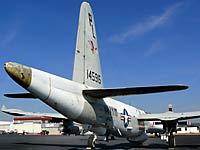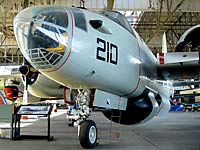| page 1 of 2 |
| Quonset Air Museum - Lockheed P2V-7 Neptune
Bill Maloney 5/10/2009 |
| page 1 of 2 |
 |
 |
| Another Lockheed P2V Neptune Patrol Bomber can be found at the Mid Atlantic Air Museum in Reading, PA | A Lockheed P2V Neptune Patrol Bomber at Floyd Bennett Field, Brooklyn, NY |
Length: 91 feet 8 inches
Wingspan: 103 feet, 10 inches
Height: 28 feet, 0 inches
Crew: 6. Pilot, copilot, engineer, 3 sensor operators
Weight: Empty 43,000 lbs Loaded - 80,000 lbs
Max Speed: 364 mph
Cruise Speed: 190 mph
Range: 4,300 miles
Service Ceiling: 22,500 feet
Armament:
Ten 5" Mk36 Rockets
10,000lbs Bombs/Torpedoes
Powerplant: Two Wright R-3350-32W Cyclone air cooled radial engines, 3,700hp each, two Westinghouse J34 Turbojet Engines, 3,400lbs thrust each
Fuel Capacity:
Center Section Tanks: 700 gal each 2 tanks = 1,400 at 8,400 lbs
Wing Tanks: 700 gal each 2 tanks = 1,400 at 8,400 lbs
Bomb Bay tanks: 350 gal each 2 tanks = 700 gal 4,200 lbs
Wing Tip tanks: 200 gal each = 400 gal 2,400 lbs
Total Fuel Capacity: 3,900 gal = 23,400 lbs
First Flight: 1946
Cost: $
Quonset Air Museum Main Page
Aviation & Military Museums Main Page